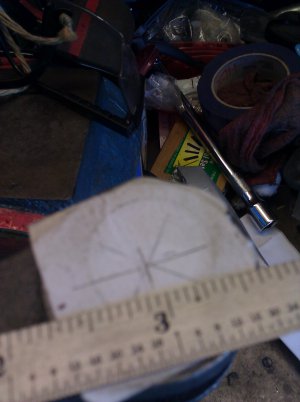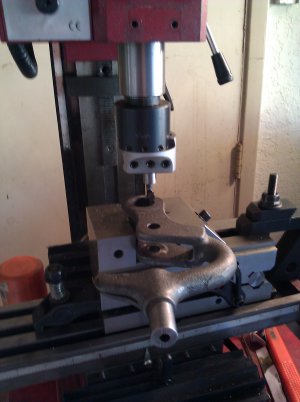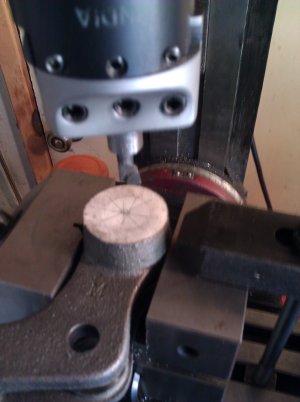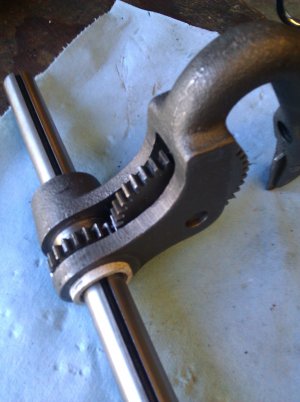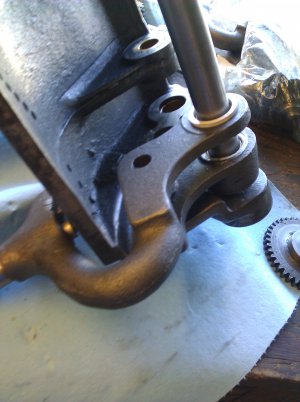Re: Greg's Logan 820 Restoration - still on the QCGB shift arms
It's been a few weeks since you last heard from me... Having successfully straightened out the warped shift arm, I decided to bore and bush the shift arms, as had been suggested. I had misgivings about tackling this enhancement, but finally decided it was worth a try, assuming I could get a good setup in my mini-mill.
To improve the odds of success, I machined a support spacer and a centering jig/bore gauge. You can see them in this photo of my milling setup.
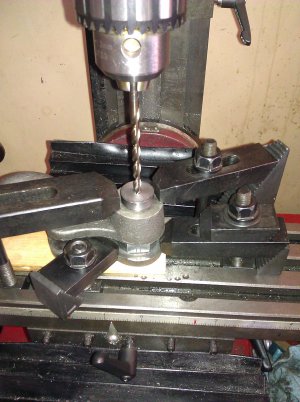
The spacer was a nut, milled down to 0.492" thick, with a 7/8+" hole bored through. It is to prevent re-bending the arm under the clamping and boring forces and sits in the gap between the fork arms. You see it between the two lower clamp arms.
Between the two upper clamp arms, positioned for centering the quill is the jig, made from the head of a 3/4" bolt. Its bottom half is 3/4", to fit the existing holes in the casting and it has a tapped 1/4-20 hole down its center. In the photo, a drill bit being used for X-Y alignment before I switch to the boring head. The top half of the jig is 0.875" O.D. Flipping it over and screwing a bolt into the hole as a handle gives me a bore gauge to check the fit of my bronze bushings into the casting.
A thin piece of hardwood, with a cutout to improve the support, sits under the casting so I don't try to bore into the bed.
...
Given that I've ignored the "if it works, don't **** with it" warning, have I taken adequate precautions? I think so. Did I forget anything? I don't think I did.
How did it turn out? (Note: references to X and Y are as the casting is clamped in the mill in the above photo, i.e. X is the long dimension of the arm.)
Not very well! What went wrong? The first piece I did was the right side arm. The apparent root problem was that the boss on the bottom of the casting (the side against the wood ) was not quite perpendicular with the intended hole centerline. So while the boring may have been on center at the start, it was crooked in both x and y so that by the end of the bore, it was way off: 0.030" X and 0.094" Y. A trial fitting of the shift arm on the slider shaft in the gearbox showed this was crooked enough to interfere with the guide arm/guide slots and detent pin alignment. I'm not sure how badly it impacted the gear alignment; regardless it needed to be fixed. I will discuss that below.
On the second arm, given the mess I'd made on the first one, I bored one side, flipped it over, and did the other. Much better, but still not perfect. It should be close enough.
To fix the right arm, my plan was to machine some steel inserts, epoxy them into place, and rebore. With the crooked holes, I also had lost the "proper" center point. So I had to calculate the proper center, in X it was based on the pitch radii of the two gears. In Y, a line through the big hole center and the small hole center should be near the edge of the hole for the guide pin. To ensure proper Z-alignment this time, I put a rod thru the small holes and shimmed the casting until the rod was parallel with the quill. (Yes, the mill is in-tram.)
This fix didn't work, the epoxy (JB-Weld) didn't hold, and the insert broke loose during boring.
What do I try next? My remaining idea is drill and tap three holes radially around the approximate centerline, then use setscrews to manuever the bushing and casting into position so the gears properly mesh and the shaft is in alignment. Once I am satisfied, I will lock them in place with the JB Weld to fill the gaps.
If that doesn't work, maybe I go to a local machine shop and see what they can do.
Anyone got any other ideas? Or a spare right shift arm for sale? (None on eBay or at Logan)
Greg




